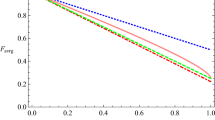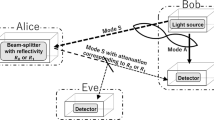Abstract
We report on a simple alternative method for the compensation of quadrature imbalance in optical quadrature phase-shift-keying (QPSK) coherent systems. By introducing a new metric, the phase imbalance can be determined and compensated. The proposed method is theoretically and numerically analyzed. In particular, it is shown that the method exhibits a small bias of estimated phase imbalance value. Thanks to its deterministic property, this bias can be simply compensated by incorporating at the receiver a phase rotator (or phase shift) whose value can be determined based on an analytical analysis. Moreover, the algorithm is also experimentally validated through bit-error-rate and error vector magnitude (EVM) measurements. A good agreement on the performance of the proposed method with that of the Gram–Schmidt orthogonalization procedure is shown in a 20-Gbit/s optical QPSK experiment. The robustness of both methods was verified with up to \(30^\circ \) phase imbalance by comparing the signal with and without phase imbalance compensation. A 10% reduction in EVM is achieved with our method for a high phase imbalance of \(30^\circ \), while the implementation complexity can be reduced owing to the suppression of the use of square-root operators.








Similar content being viewed by others
References
Raybon, G., Adamiecki, A., Winzer, P.J., Randel, S., Salamanca, L., Konczykowska, A., Jorge, F., Dupuy, J.-Y., Buhl, L.L., Chandrashekhar, S., Xie, C., Draving, S., Grove, M., Rush, K., Urbanke, R.: High symbol rate coherent optical transmission systems: 80 and 107 Gbaud. J. Lightwave Technol. 32, 824–831 (2014)
Ip, E., Lau, A.P.T., Barros, D.J.F., Kahn, J.M.: Coherent detection in optical fiber systems. Opt. Express 16, 753–791 (2008)
Valkama, M., Renfors, M., Koivunen, V.: Advanced methods for I/Q imbalance compensation in communication receivers. IEEE Trans. Signal Process. 49, 2335–2344 (2001)
Liu, X.: Receiver sensitivity improvement in optical DQPSK and DQPSK/ASK through data-aided multi-symbol phase estimation. In: Proceeding of ECOC, p. Th.4.4.5 (2006)
Savory, S.J.: Digital filters for coherent optical receivers. Opt. Express 16, 804–817 (2008)
Ip, E., Kahn, J.M.: Compensation of dispersion and nonlinear impairments using digital back propagation. J. Lightwave Technol. 26, 3416–3425 (2008)
Anttila, L., Valkama, M., Renfors, M.: Circularity-based I/Q imbalance compensation in wideband direct-conversion receivers. IEEE Trans. Veh. Technol. 57, 2099–2113 (2008)
Schenk, T.C.W., Smulders, P.F.M., Fledderus, E.R.: Estimation and compensation of frequency selective TX/RX IQ imbalance in MIMO OFDM systems. In: Proceedings of IEEE International Conference on Communications, pp. 251–256 (2006)
Liu, C.-H.: Joint Tx and Rx IQ imbalance compensation of OFDM transceiver in mesh network. In: Proceedings of Globel Telecommunications Conference, pp. 704–708 (2008)
Chung, W.: Transmitter IQ mismatch compensation in coherent optical OFDM systems using pilot signals. Opt. Express 1, 21308–21314 (2010)
Ma, X., Li, K., Bai, Y.: Novel training symbol structure for transmitter IQ mismatch compensation for coherent optical OFDM. IEEE Photon. Technol. Lett. 25, 2047–2049 (2013)
Cao, S., Yu, C., Kam, P.Y.: Decision-aided joint compensation of transmitter IQ mismatch and phase noise for coherent optical OFDM. IEEE Photon. Technol. Lett. 24, 1066–1068 (2012)
Fatadin, I., Savory, S.J., Ives, D.: Compensation of quadrature imbalance in an optical QPSK coherent receiver. IEEE Photon. Technol. Lett. 20, 1733–1735 (2008)
Chang, S.H., Chung, H.S., Kim, K.: Impact of quadrature imbalance in optical coherent QPSK receiver. IEEE Photon. Technol. Lett. 21, 709–711 (2009)
Petrou, C.S., Vgenis, A., Roudas, I., Raptis, L.: Quadrature imbalance compensation for PDM QPSK coherent optical systems. IEEE Photon. Technol. Lett. 21, 1876–1878 (2009)
Qiao, Y., Xu, Y., Li, L., Ji, Y.: Quadrature imbalance compensation algorithm based on statistical properties of signals in CO-QPSK system. Chin. Opt. Lett. 10, 120601 (2012)
Nguyen, T.-H., Gomez-Agis, F., Gay, M., Anet-Neto, L., Scalart, P., Peucheret, C., Joindot, M., Sentieys, O., Simon, J.-C., and Bramerie, L.: IQ imbalance compensation based on maximum SNR estimation in coherent QPSK systems. In: Proceedings of IEEE International Conference on Transparent Optical Network, p. Tu.C1.3 (2014)
Razavi, B.: Design considerations for direct-conversion receivers. IEEE Trans. Circuits Syst. II, Analog Digit. Signal Process. 44, 428–435 (1997)
Cardoso, J.-F., Laheld, B.H.: Equivariant adaptive source separation. IEEE Trans. Signal Process. 44, 3017–3030 (1996)
Vitthaladevuni, P.K., Alouini, M.-S.: A recursive algorithm for the exact BER computation of generalized hierarchical QAM constellations. IEEE Trans. Inf. Theory 49, 297–307 (2003)
Mizuochi, T.: Recent progress in forward error correction and its interplay with transmission impairments. IEEE J. Sel. Topics Quantum Electron. 12, 544–554 (2006)
OIF: Implementation agreement for integrated dual polarization intradyne coherent receiver. IA# OIF-DPC-RX-01.2
Proakis, J.: Digital Communications (Chap. 5 and 11), 4th edn. McGraw-Hill, New York (2000)
Viterbi, A.J., Viterbi, A.M.: Nonlinear estimation of PSK-modulated carrier phase with application to burst digital transmission. IEEE Trans. Inf. Theory 29, 543–551 (1983)
McKinley, M.D., Remley, K.A., Myslinski, M., Kenney, J.S., Schreurs, D., Nauwelaers, B.: EVM calculation for broadband modulated signals. In: Proceedings of 64th ARFTG Conf. Dig., pp. 45–52 (2004)
Fatadin, I., Ives, D., Savory, S.J.: Laser linewidth tolerance for 16-QAM coherent optical systems using QPSK partitioning. IEEE Photon. Technol. Lett. 22, 631–634 (2010)
Winzer, P.J., Gnauck, A.H., Doerr, C.R., Magarini, M., Buhl, L.L.: Spectrally efficient long-haul optical networking using 112-Gb/s polarization-multiplexed 16-QAM. J. Lightwave Technol. 28, 547–556 (2010)
Magnus, W., Oberhettinger, F., Soni, R.P.: Formulas and Theorems for the Special Functions of Mathematical Physics, 3rd edn. Springer, New York (1966)
Acknowledgements
This work was supported by the French National Research Agency (ANR) in the frame of the OCELOT Project (Ref. ANR-10-VERS-0015), the Contrat de plan Etat-Région Ponant and the French Ministry of Research.
Author information
Authors and Affiliations
Corresponding author
Appendices
Appendix A
Based on the definition of the new metric in (4), the squared modulus of r can be written as
in which the variables U, X, V and Y are defined by
We first calculate the expected value of \({| r |^2}\). From (A.1), the expectation of \(r^2\) is calculated as follows
It must be noted that the expected values of U, V, X and Y are zero. On the other hand, U and X, V and Y are uncorrelated so that the last two terms of (A.3) are equal to 0. Moreover, \(\phi _S\) is uniformly distributed over the four values \((2k+1)\cdot \pi /4\), \(k = 0, 1, 2, 3\). Using the quantities defined in (A.2), the variances of U, V and their covariance can be retrieved as
As mentioned, \(n_C\) and \(n_S\) are random Gaussian variables with the same variance \(\sigma ^2\). The variances of X, Y and their covariance are
Finally, the expected value of \({| r |^2}\) is derived by [as in Eq. (7)]
The following part is the derivation of the variance of \({\left| r \right| ^2}\). The variance of \({| r |^2}\) can be written as
Due to the assumption of central and uncorrelated variables, some terms cancel and the expectation of \({| r |^4}\) can be written as
Based on the definition of the QPSK signal, \((U^2 + V^2)\) is a random discrete variable taking on two equiprobable values, \(1/2\cdot (1 + (\alpha + \beta )^2)\) and \(1/2\cdot (1 + (\alpha - \beta )^2)\). The first term of (A.8) can then be derived as
The second term of (A.8) is calculated using the fact that all the moments of a zero-mean Gaussian variable can be derived from its variance [28]. More specifically, the fourth-order moments of (X, Y) can be written as
Therefore, the second term of (A.8) is given by
\((U^2 + V^2)\) and \((Y^2 + X^2)\) are independent random variables. The third term of (A.8) is then obtained
Due to the independence property between the variables (U, V) and (X, Y), the last term of (A.8) can be reformulated as
The last term is expressed as
From (A.9), (A.11), (A.12) and (A.14), the variance of \({| r |^2}\) is finally derived [as in Eq. (8)]
Appendix B
If \({\phi _0} = \arg \mathop {\max }\limits _{{\phi _\mathrm{var}}} \left( {{D_{\left( {wo} \right) }}\left( {{\phi _\mathrm{var}}} \right) } \right) \) or \(\tan \phi _0 = -\sin \phi _\mathrm{mis}\), we evaluate the first derivative of \(D(\phi )\) at \(\phi = \phi _0\). To do that, the expression of D in Eq. (9) is represented as follows
where \(Z = (1/2+\sigma ^2)^2\) and \(S = 2\sigma ^2(1+\sigma ^2)\). If we call \({F_S}\left( \phi \right) = \frac{{{\beta ^2}\left( {{\alpha ^2} - 2S} \right) }}{{{{\left( {1 + {\alpha ^2} + {\beta ^2}} \right) }^2}}}\), Eq. (B.1) can be rewritten by
By inspecting Eq. (B.2), it can be observed that the extremum of D corresponds to the extremum of \(F_S(\phi )\). Instead of evaluating the first derivative of D at \(\phi = \phi _0\), we can equivalently investigate the first derivative of \(F_S(\phi )\) at \(\phi = \phi _0\). In order to simplify the expression, the following variables and its corresponding derivative at \(\phi = \phi _0\) are established
The expression of \(F_S(\phi )\) is now given by
and its first derivative at \(\phi = \phi _0\) can be established
or equivalently,
in which K is calculated by
Due to the fact that \(\tan \phi _0 = -\sin \phi _\mathrm{mis}\) and from the definition of \(\beta \) in Eq. (6), the values of \(v_0\) and \(v'_0\) can be deduced as follows
Substituting (B.8) into (B.7), K can be obtained as
From (B.6) and (B.9), it can be concluded that K is different from 0 and hence the first derivative of \(F_S(\phi )\) at \(\phi = \phi _0\) is also not equal to 0 whenever \(S \ne 0\). As a consequence, the first derivative of \(D(\phi )\) at \(\phi = \phi _0\) differs from 0, so the dependence of the maximum value of D on the SNR of the received samples is confirmed.
Rights and permissions
About this article
Cite this article
Nguyen, TH., Scalart, P., Gay, M. et al. New metric for IQ imbalance compensation in optical QPSK coherent systems. Photon Netw Commun 36, 326–337 (2018). https://doi.org/10.1007/s11107-018-0783-7
Received:
Accepted:
Published:
Issue Date:
DOI: https://doi.org/10.1007/s11107-018-0783-7




